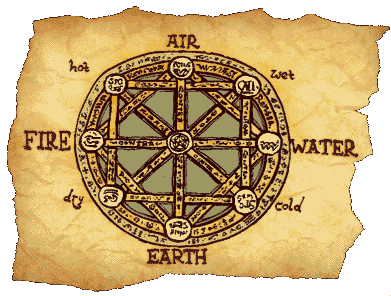
The Elements:
The Classical Elements:
The ancient Greeks are often credited with discovering, or at least providing the concept for, the atom. Indeed, one Greek philosopher, Democritus, probably did believe this, or at least provided the theory as a topic for debate. However, the majority of Greeks who gave thought to the subject believed that the smallest unit that anything could be divided into was the element.
Aristotle named four elements; fire, air, earth and water. However, for some years after this, philosophers argued which of these four elements was the main one. Thales argued that everything was made of water, while Heraclitus disagreed and claimed that fire was the major element, and Anaximenes refused to believe either and put forward air as the obvious candidate.
This argument could have gone on for a long time, as there was no hard way to prove the answer either way, until a philosopher called Empedocles decided that everybody had the same right to be correct. He proposed that everything was made up of a mixture of the four elements, and proposed a simple experiment to prove his point.
Empedocles set light to a stick. While this might not seem to be the most ground-breaking piece of scientific research ever made, it convinced the philosophers to stop bickering and take his opinion to heart.
The concept of elements gave rise to one of the most fundamental theories of later alchemy: the idea that the properties of a substance depend on what it is made of.

Aristotle classified the elements on whether they were hot or cold and whether they were wet or dry.
Alchemical Elements:
By the Middle Ages, people had started to see that the Greek system of classical elements was not absolutely universal. Substances like mercury defied the old categorisations, so the alchemists made up three more to complement the Aristotelian system.
These new elements had new properties, and this excited the alchemists, who believed that they could now make new and different substances, or, even better, make valuable ones easily.
For instance, it was clearly possible to remove the liquidity from mercury in order to make pure silver. This became a common theme in alchemy: If a substance had a list of properties, i.e. acidity, solidity, waxiness or flammability, then that substance could be made from other materials that shared some properties but differed in others. For instance, in theory it might be possible to make gold from sulphur, lead and mercury because it will have the yellowness from the sulphur, the metallicity from the lead and the shininess from the mercury.
The Spheres
The concepts of animal, vegetable and mineral are fairly familiar to most people. Minerals are not alive and cannot move, vegetables are alive but cannot move, and animals are alive and can move. Alchemists first devised this system and linked each of the spheres to one of their new elements.
Some alchemists believed that the whole of divine Creation was based upon their spheres. Hence, God made the mineral sphere first, then the vegetable sphere, then the animal sphere. In addition, He made each sphere from the previous one, and, with the right tools of transformation, the skilled alchemist might be able to do the same.
The transformation index went like this (spheres are colour-coded)
It is probable that alchemists considered man (probably not woman, in the misogynistic world of the Middle Ages) the highest rung on the ladder, hence there were to be no superior beings except God.
The transformations could be instantly performed, it was believed, using a substance called the Philosopher's Stone (not just a plot device for J. K. Rowling). The search for this sought-after item was one of the central tenets of alchemy.